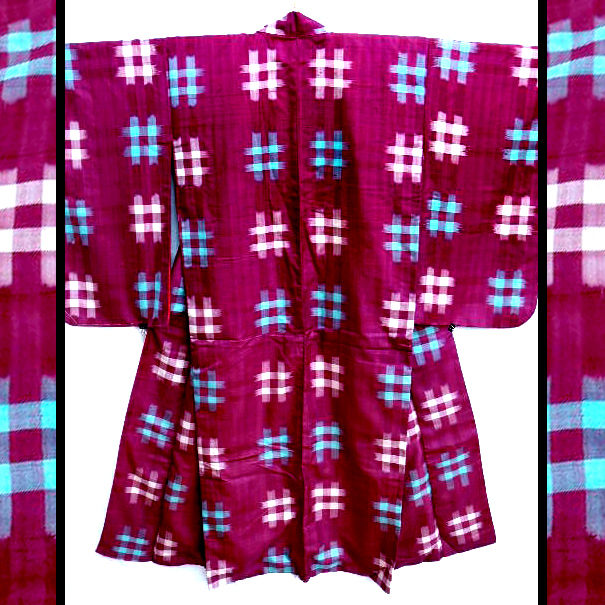- A gorgeous, antique, meisen silk kimono, in a deep magenta-purple colour, with extremely deep sleeves. It has an igeta pattern, igeta is the shape of a Japanese well's top, a popular, traditional Japanese motif.
- Meisen silk is similar to soft, silk taffeta, with a slight hint of body to it, helping it hold its shape, although it is also very soft. It feels lovely. Meisen silk, generally crisp and supple, is one of the Japanese silks fabricated by weaving pre-dyed threads, utilizing the tie-and-resist ikat technique. In this process, the threads, usually silk or cotton, are first stretched on a frame, then selected design areas are tightly bound to prevent the dye from penetrating, and the hanks of threads are immersed in the dye pots. The bound portions of the yarns resist the dye and, as a result of the threads not being perfectly aligned, create shapes with charmingly uneven edges to the pattern when woven. The design is applied to both the warp and weft yarns (heiyo gasuri). Meisen silk was a particularly popular fabric for casual kimono from 1920 to 1950, in part because it was more affordable and in part because the designs, frequently drawing on Western influences, seemed adventurous and innovative. Even today they retain a contemporary sensibility.
- Meisen kimonos from the early 20th century to be a little shorter than later kimonos, though still very long. Meisen kimonos are sought after by kimono collectors, as the supply of good condition ones gets smaller and smaller.
- Please don't make the mistake of thinking that 100 years old means it has any weaknesses. Kimonos are so expensive that the Japanese take immense care of them, so they often stay in exquisite condition, like this one, which it has many, many more years of wear in it.
- Fully lined
- Made in Japan
- May have shitsuke-ito stitching around the edge; shitsuke-ito is loose, temporary stitching that the Japanese put in to keep edges neat during storage, it just gets pulled out before wearing. These are often a sign that the garment has never been used
- Made in Japan
- **If shown with a sash or accessories, they are not included; for display purposes only, to let you see it closed, however, all kimono require an obi or some sort of sash to hold them closed; these are always bought separately. Think of it like a skirt and blouse, you can't wear either on its own, you buy them separately and mix and match
Condition:
Excellent
To judge fit on you...
Check height: Women can choose kimono that are longer than their height, as any excess material is then traditionally folded over at the waist (see below)
Check width: A kimono with a width that is at least 16” (40cm) greater than your hip size will fit perfectly, although if the width of the kimono is not at least 10” (25cm) greater than your hip size, your legs may be visible as you walk, there’s nothing wrong with that of course, but it’s not the traditional way
Sleeve length: Measure from centre back of neck, along shoulder and down the arm to the wrist, then double that and compare it with the sleeve end measurement to judge sleeve length
Adjusting the Length the traditional way
Pull up your kimono until the bottom reaches the correct length, then tie it in place round your waist with a ribbon or a koshi himo (kimono tie). Fold the excess material down over the tie. This fold-over is called ohashiori and is always present on women's kimonos. Fasten an obi or wide belt or sash around the waist, over the top of the folded over fabric, which usually shows below
Measurements approximately:
Sleeve end to sleeve end 126cm
Sleeve seam to sleeve seam 61cm
Length 143cm
-----------------------------------------------------
wk813/05/13
Taisho Igeta Design Kimono
Women's Kimonos 45% off
Kimono require a sash to hold them closed. This is always bought separately. Men usually wear a kaku obi with their kimono or, casually at home, a soft heko obi
Sizing: Japanese clothing is usually of adjustable fit, being mostly wrap-over or tie-to-fit items, so most garments fit a range of sizes. Because of this (and only really knowing my own size anyway) I can't really advise anyone on the fit. Please judge fit from the measurements given. Check length given for the garment, then measure from base of back of your neck down to judge that length on you
Also measure from centre back of neck, along shoulder and down the arm to the wrist, then double that and compare it with the sleeve end measurement to judge sleeve length
Storage: Hang up your garment for a few hours prior to wearing, to remove fold creases. They should also be hung out to air 4 times per year, if not worn frequently
Some of my garments have white stitching (shitsuke) round the outside edges to keep the edges flat during long periods of storage, these stitches just get pulled out before wearing the garment
Cleaning: Be very cautious about washing kimonos. All cleaning is done entirely at your own risk, as is standard with all vintage garments and items. I would advise only dry cleaning
Colour: Please be aware that different monitors display colour slightly differently. Therefore the colour in the photos and description is a guide only



